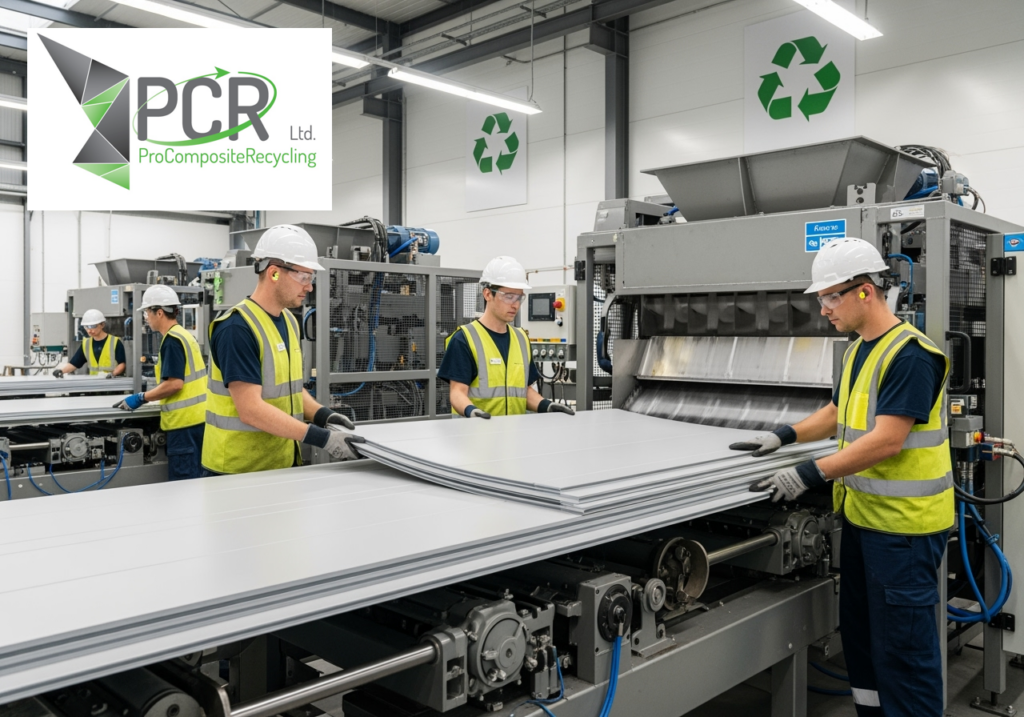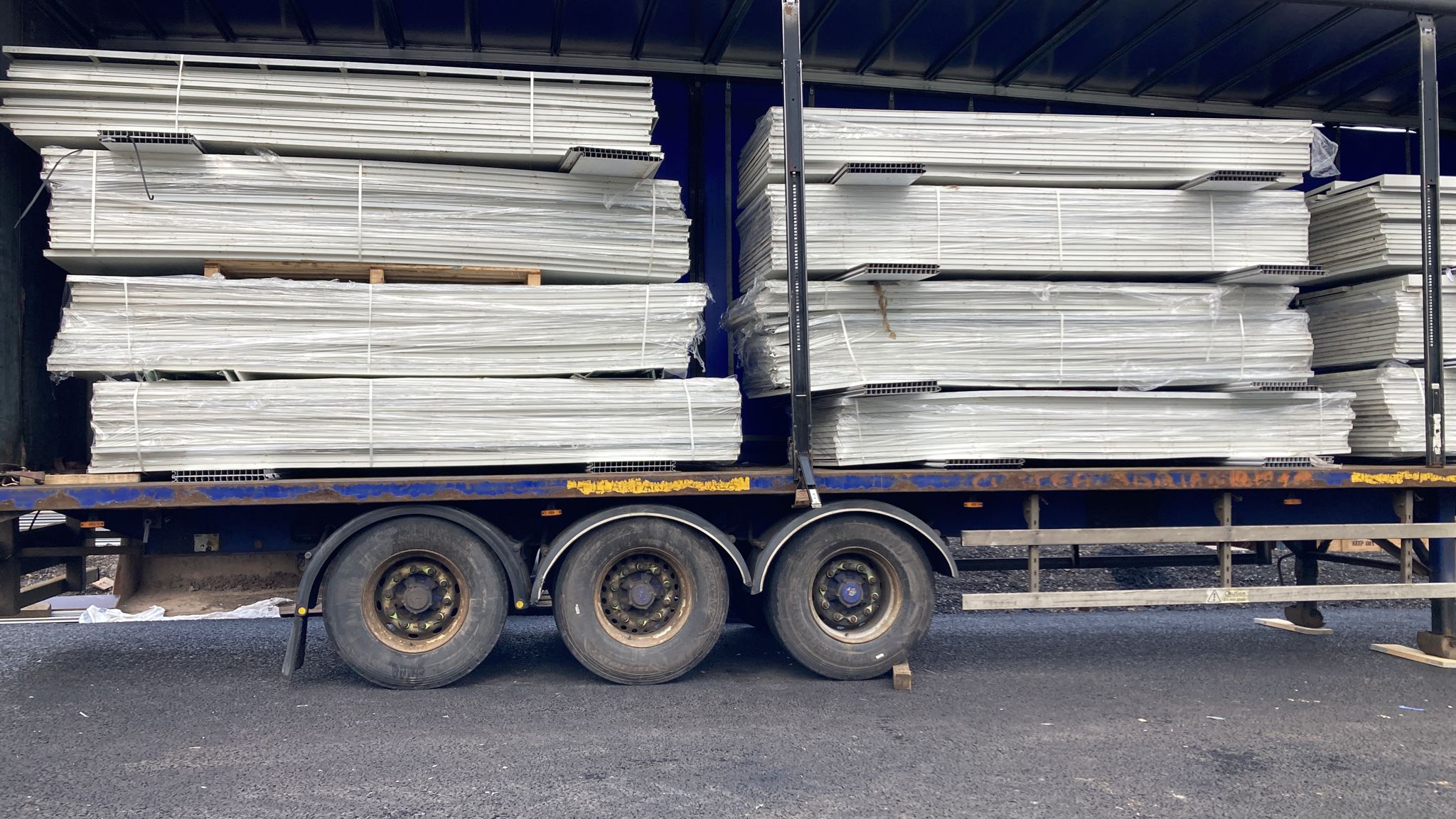ACM RECYCLING SERVICE
ARE YOU INVOLVED IN A PROJECT FOR THE REMOVAL AND RE-CLADDING OF ACMS?
- +44 (0)3301 75 75 07
- [email protected]
Exclusively partnered with Pro Composite Recycling, PCS can now offer a closed-loop recycling solution for Aluminium Composite Materials (ACM) in the UK and Ireland, ensuring 100% of waste from ACMs are diverted from landfill.
Waste ACMs are typically difficult to recycle and usually end up in landfill. With the extensive removal and replacement of cladding across the UK, waste ACMs are becoming a significant problem for landfill, with the alternative to ship it overseas.
Working with Pro Composite Recycling’s processing facility in Dudley, we can process your waste ACMs by separating the layers into aluminium and polyethylene (PE) ready for use in future manufacturing.
This process diverts 100% of waste material from landfill.
Our partnership with PCR now provides our clients with a unique opportunity in the UK to ensure waste from fabricated ACM materials and any ACM cladding removed deemed as unsuitable can now be effectively recycled in the UK’s first closed-loop recycling solution.


The recycling process:
- Sorting – The aluminium with the plastic film and adhesive is segregated from other materials like paper, glass, and other metals.
- Shredding – The sorted aluminium is then shredded into small pieces to make the separation process easier.
- Heating – The shredded aluminium is then heated in a furnace to melt it.
- De-coating – While the aluminium is melting, the plastic film and adhesive coating will burn off at a lower temperature and become gases. These gases can be captured and processed to minimise emissions.
- Skimming – Once the aluminium is molten, the remaining plastic and adhesive residue will float to the top and can be skimmed off the surface.
- Solidifying – The molten aluminium is then poured into moulds to solidify into ingots or other forms that can be used to make new aluminium products.
- Recycling – The solidified aluminium can then be recycled into new products, reducing the need for virgin materials and minimising waste.
It’s worth noting that the specific process for recycling aluminium with plastic film and adhesive may vary depending on the recycling facility and/or local authority restrictions. Additionally, not all recycling facilities may be equipped to handle this type of material, so it’s important that end-users check with their local recycling centre and/or local council to determine what materials they can accept.
POST-GRENFELL RECLADDING
Introduction
In the wake of the Grenfell Tower tragedy, the UK construction industry has undergone a fundamental transformation. With over £5 billion in remediation costs identified and strict government deadlines looming, the demand for safe, sustainable cladding solutions has never been higher. Pro Composite Recycling Ltd. (PCR), part of the PCS Ltd family, is at the forefront of this revolution, offering innovative recycling solutions that support the transition to fire-safe materials while addressing environmental concerns.
The Post-Grenfell Landscape: A Market in Transformation
The statistics paint a stark picture of the challenges ahead:
- 500-3,400 buildings require remediation
- Hard deadlines: end of 2029 for buildings 18m+, 2031 for 11-18m buildings
- £3.4 billion Building Safety Levy starting 2026
- 24,000 residents rehoused since December 2024
This massive undertaking presents both challenges and opportunities. While the focus rightly remains on fire safety, the environmental impact of removing and disposing of millions of square metres of non-compliant cladding cannot be ignored.
PCR: Turning Waste into Opportunity
Pro Composite Recycling addresses this dual challenge head-on. As specialists in aluminium composite material (ACM) recycling, PCR Ltd. provides a sustainable solution for the vast quantities of cladding materials being removed from buildings across the UK.
Key Benefits of PCR’s Recycling Solutions: Environmental Impact Reduction
- Diverts ACM waste from landfills
- Recovers valuable aluminium for reuse
- Reduces the carbon footprint of remediation projects
- Supports circular economy principles in construction
Cost-Effective Disposal
- Competitive rates for ACM waste processing
- Reduces disposal costs for contractors
- Potential revenue generation from recovered materials
- Streamlined collection and processing services
Compliance and Documentation
- Full audit trails for waste disposal
- Certificates of destruction/recycling
- Supports sustainability reporting requirements
- Meets environmental compliance standards

Supporting ALPOLIC™: The Gold Standard in Fire Safety
PCR’s recycling services perfectly complement PCS Ltd’s role as the exclusive UK supply partner Company for ALPOLIC. As contractors remove non-compliant materials, PCR ensures responsible disposal while PCS can supply the replacement solution: ALPOLIC™ NC/A1.
ALPOLIC™ NC/A1: The Superior Choice
- World’s first non-combustible fire class A1 aluminium panel
- Geo mineral compound core technology
- Meets EN 13501-1 Reaction to Fire Classification A1 and A2-s1, d0
- Achieved EN 13501-2 E15 Fire Resistance Testing
- Backed by comprehensive BS8414 fire test results
- BBA Accredited and CWCT Tested
- 50 years of manufacturing expertise
This creates a complete circular solution: PCR handles the sustainable disposal of old materials while PCS provides the fire-safe replacement, ensuring projects meet both safety and environmental standards.
The Competitive Advantage
In a market where compliance confusion and regulatory bureaucracy create challenges, PCR offers clarity and reliability:
- One-Stop Solution: Combined recycling and supply services from the PCS Ltd group
- Industry Expertise: Over 15 years of experience in composite materials
- Proven Track Record: Established relationships with contractors and architects
- Technical Support: Full technical guidance on both disposal and replacement
- Regulatory Knowledge: Deep understanding of Building Safety Act requirements
Market Outlook and Opportunities
With the Building Safety Regulator operating under MHCLG and a 36-week backlog of applications, the remediation market will remain active well into the 2030s. PCR is positioned to capture significant market share by offering:
- Scalable recycling capacity
- Nationwide collection services
- Competitive processing rates

Conclusion
As the UK construction industry navigates the post-Grenfell landscape, companies like PCR are proving that safety and sustainability can go hand in hand. By providing responsible recycling solutions for removed cladding materials while supporting the supply of fire-safe ALPOLIC products, PCR is helping to build a safer, more sustainable future for UK buildings.
The combination of PCR’s recycling expertise, PCS Ltd’s ALPOLIC partnership, and the versatile product range creates a comprehensive solution for the challenges ahead. As remediation projects accelerate towards the 2029 and 2031 deadlines, PCR stands ready to support contractors, architects, and building owners in achieving their safety and sustainability goals.


